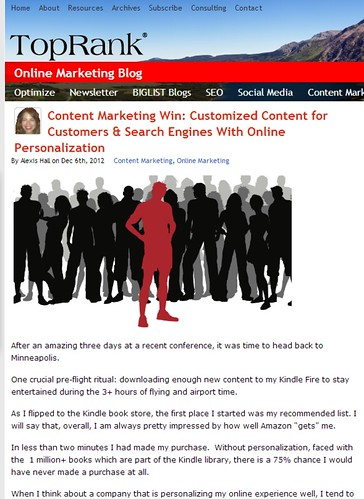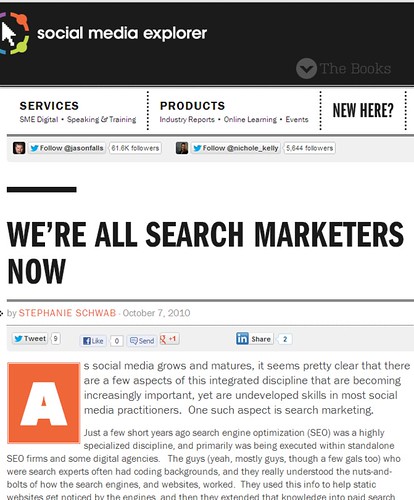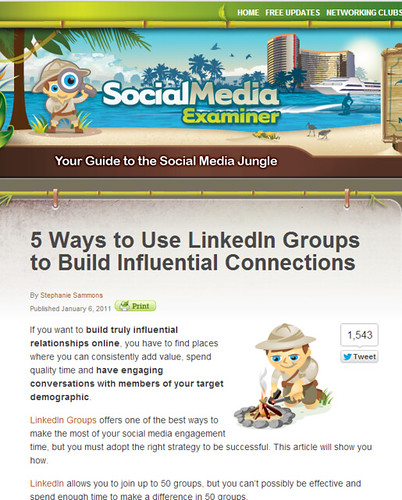 News on Social Marketing, according to Top Rank Blog : Companies that are personalizing online experience are more likely to help customers decide on making a purchase.
News on Social Marketing, according to Top Rank Blog : Companies that are personalizing online experience are more likely to help customers decide on making a purchase.
However, if many people can find your content through search but it’s not engaging, or if the content is hard to find but highly engaging, no one wins. To be able to gain success, it is vital to optimize customer experience and discovery, through search.
Personalization was one of the topics at a conference given by Michael DeHaven of Bazaarvoice and Greg Ott of DemandBase. “Personalization: Delivering Customer Content to People and Bots.”
Michael DeHaven discussed 4 types of online personalization.
– Site Wide Personalization refers to serving personalized site content as well as other identifying information – like gender, demographics, etc. Having a customized page, like the Webinar titles seen on the side bar, will most likely convert users.
– Product Recommendations – one of the best examples in doing personalized product recommendations is Amazon.
– Evaluation Personalization – reading reviews helps customers make a decision on a product or service. And because most customers only wants to read about 7 reviews, it is best for marketers to serve reviews based on factors which are most compelling to users: Sufficiently long, inclusive of rich media – like images, video, etc, Inclusive SEO targeted keyword phrases and use of search terms
– Device Personalization – to help missing out on an opportunity, it is important to personalize the experience of an iPhone, tablet, etc as personalization goes beyond content and extends to the device.
Greg Ott: 4 steps to online personalization
Step 1: Determine who you are Personalizing For
Step 2: Determine What you Know About Them
Step 3: Decide what to Show
Step 4: Find out if it Works
Personalization makes life so much easier for consumers, so look beyond product recommendations and consider all the aspects of a site you can customize and optimize for your customers.
Read more at Content Marketing Win: Customized Content for Customers & Search Engines With Online Personalization
 News on Social Marketing, according to Social Media Explorer: Search marketing is one of the few aspects of social media that are becoming increasingly important, yet are undeveloped skills in most social media practitioners. Before, one of the highly specialized discipline, and primarily was being executed within standalone SEO firms and some digital agencies was the SEO (Search Engine Optimization). Search experts often had coding backgrounds and really understood how the search engines, and websites, worked.
News on Social Marketing, according to Social Media Explorer: Search marketing is one of the few aspects of social media that are becoming increasingly important, yet are undeveloped skills in most social media practitioners. Before, one of the highly specialized discipline, and primarily was being executed within standalone SEO firms and some digital agencies was the SEO (Search Engine Optimization). Search experts often had coding backgrounds and really understood how the search engines, and websites, worked.
Today, more agencies: PR, digital and pure-play social, is building client blogs. And most of them no longer hire an SEO company every time they build a blog as they have built up enough SEO expertise in-house to be able to create and implement a search-friendly blog and then train the writers on at least basic best practices of search-optimized writing.
Search marketing s now part of nearly every aspect of social media, from Twitter to YouTube, Facebook to Flickr. It has gone far beyond websites and blogs. However, most social media practitioners are not always fully equipped to manage search optimization on social platforms.
Optimizing videos in YouTube can now be done. Your video can now be easily found in YouTube, including other search engines like Google, by including the right keywords, writing keyword-rich descriptions and uploading video transcripts.
To get your brand ranked in search engines, a powerful tool like Twitter is needed. With your profile, you can use your real name/brand name as your Actual Name in Twitter even if you can’t get your perfect username.
The search potential with Facebook seems pretty good because of its more than 500 million users. However, there is a slow development on the search engine’s search function because it is not clearly optimizable. Best practices for Facebook search optimization includes appropriate keyword use; choosing the right name/URL for your Facebook page; and using the About text box for keyword-rich copy.
Read more at WE’RE ALL SEARCH MARKETERS NOW
 News on Social Marketing, according to Social Media Examiner: Having an engaging conversation, finding places where you can consistently add value and spend quality time with members of your target demographic is important to build an influential relationship online.
News on Social Marketing, according to Social Media Examiner: Having an engaging conversation, finding places where you can consistently add value and spend quality time with members of your target demographic is important to build an influential relationship online.
LinkedIn Groups is showing that the best way to succeed in making the most of your social media engagement is by focusing your effort and time on a deep and narrow approach in order to build influence within LinkedIn Groups, enhance your credibility and generate new connections.
Here’s how:
#1: Identify the Best Group Opportunities
To maximize your visibility, focus on the top 3 to 5 groups that most accurately represent your target demographic and choose groups that have at least a few hundred members, but no more than a few thousand.
#2: Target the Most Popular Discussions in Each Group
Review and learn from the most “popular” discussions within a group and as you weigh in on popular discussions, respond to existing comments, provide an insight or opinion or even ask a thought-provoking question to generate additional comments. These are the topics where members are most actively engaged. If your comments add value to the popular discussions, members will begin to recognize you as a thought leader within the group.
#3: Start Your Own Discussion
After participating in the top discussions on #2, start your own strategic discussion thread as this is also a powerful tool within a group. And to understand their concerns, goals and objectives, observe the contributions of the most active group members and identify what seems to be important to them.
#4: Follow Up and Follow Through
Because it is difficult to keep up with updates on LinkedIn Groups, it is wise to not let too much time lapse and don’t leave a conversation open. Make sure to keep up with the conversations you’re participating in. and to show your commitment to your groups, you must keep your comments fresh and interesting.
#5: Start Your Own Group
Starting your own LinkedIn Group is another option. Managing your own group give you control over a lot of aspects. You can lead discussions with the group and can control which discussions get more visibility through the “Manager’s Choice” feature.
Ultimately, it will be the members who will push the most interesting discussions to the top.
Read more at 5 Ways to Use LinkedIn Groups to Build Influential Connections
Other Social Marketing Articles of Interest
5 Ways to Use LinkedIn Groups to Build Influential Connections
